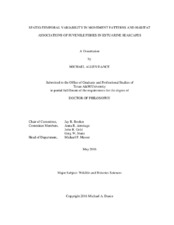| dc.contributor.advisor | Rooker, Jay R | |
| dc.creator | Dance, Michael Allen | |
| dc.date.accessioned | 2016-07-08T15:05:10Z | |
| dc.date.available | 2018-05-01T05:48:55Z | |
| dc.date.created | 2016-05 | |
| dc.date.issued | 2016-01-07 | |
| dc.date.submitted | May 2016 | |
| dc.identifier.uri | https://hdl.handle.net/1969.1/156801 | |
| dc.description.abstract | Understanding the ecological value of nursery habitats is important to the conservation of coastal fisheries. The purpose of this research was to address gaps in our knowledge of nursery habitat value for both juvenile red drum (Sciaenops ocellatus) and southern flounder (Paralichthys lethostigma) within estuarine seascapes in Texas. Acoustic telemetry and habitat suitability models were used to identify spatial and temporal variability in habitat associations and movement patterns of both species. Objectives were to determine the influence of biotic factors on transmitter performance in acoustic telemetry studies, examine habitat use and movement patterns of both species at two spatial scales (habitat and bay scale) within a model estuary, and to use generalized additive models (GAMs) to evaluate ontogenetic and regional variation in habitat suitability for red drum along the Texas coast.
Significant differences in detection probability (2-7 fold differences) were observed between internally and externally placed transmitters on red drum as well as between transmitters attached externally to red drum and those attached to a fixed line, while no species effect was observed for internal transmitters in red drum and southern flounder. At the habitat scale (1 m – 1 km), both species were associated with seagrass and edge habitat; however, rates of movement differed greatly between species, which likely reflected the use of different foraging strategies (i.e. ambush vs. active). Bay-scale (1-20 km) distribution was influenced by physicochemical conditions and seascape composition, with both species found most frequently in areas with high seagrass coverage and in close proximity to tidal creeks and connective channels. At broader, regional scales, stage-specific habitat suitability models demonstrated that fish-habitat relationships for juvenile red drum were often similar among estuaries along a latitudinal gradient; however, the relative importance of abiotic and biotic factors to red drum distribution and abundance varied, suggesting that habitat quality within each life stage may be determined by variables that have the greatest impact on survival within a particular estuary. Results of this research demonstrate that habitat use and movement patterns of estuarine fish are scale dependent and vary both spatially and temporally within and among estuarine nursery areas. | en |
| dc.format.mimetype | application/pdf | |
| dc.language.iso | en | |
| dc.subject | Habitat Use | en |
| dc.subject | Acoustic Telemetry | en |
| dc.subject | Detection Range | en |
| dc.subject | Red Drum | en |
| dc.subject | Southern Flounder | en |
| dc.title | Spatio-Temporal Variability in Movement Patterns and Habitat Associations of Juvenile Fishes in Estuarine Seascapes | en |
| dc.type | Thesis | en |
| thesis.degree.department | Wildlife and Fisheries Sciences | en |
| thesis.degree.discipline | Wildlife and Fisheries Sciences | en |
| thesis.degree.grantor | Texas A & M University | en |
| thesis.degree.name | Doctor of Philosophy | en |
| thesis.degree.level | Doctoral | en |
| dc.contributor.committeeMember | Armitage, Anna R | |
| dc.contributor.committeeMember | Gold, John R | |
| dc.contributor.committeeMember | Stunz, Greg W | |
| dc.type.material | text | en |
| dc.date.updated | 2016-07-08T15:05:10Z | |
| local.embargo.terms | 2018-05-01 | |
| local.etdauthor.orcid | 0000-0002-9881-1746 | |


